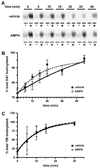Amphetamine-induced decreases in dopamine transporter surface expression are protein kinase C-independent
- PMID: 18164041
- PMCID: PMC2716702
- DOI: 10.1016/j.neuropharm.2007.11.007
Amphetamine-induced decreases in dopamine transporter surface expression are protein kinase C-independent
Abstract
Amphetamine (AMPH) is a potent dopamine (DA) transporter (DAT) inhibitor that markedly increases extracellular DA levels. In addition to its actions as a DAT antagonist, acute AMPH exposure induces DAT losses from the plasma membrane, implicating transporter-specific membrane trafficking in amphetamine's actions. Despite reports that AMPH modulates DAT surface expression, the trafficking mechanisms leading to this effect are currently not defined. We recently reported that DAT residues 587-596 play an integral role in constitutive and protein kinase C (PKC)-accelerated DAT internalization. In the current study, we tested whether the structural determinants required for PKC-stimulated DAT internalization are necessary for AMPH-induced DAT sequestration. Acute amphetamine exposure increased DAT endocytic rates, but DAT carboxy terminal residues 587-590, which are required for PKC-stimulated internalization, were not required for AMPH-accelerated DAT endocytosis. AMPH decreased DAT endocytic recycling, but did not modulate transferrin receptor recycling, suggesting that AMPH does not globally diminish endocytic recycling. Finally, treatment with a PKC inhibitor demonstrated that AMPH-induced DAT losses from the plasma membrane were not dependent upon PKC activity. These results suggest that the mechanisms responsible for AMPH-mediated DAT internalization are independent from those governing PKC-sensitive DAT endocytosis.
Figures




References
-
- Barker EL, Blakely RD. Norepinephrine and serotonin transporters: molecular targets of antidepressant drugs. In: Bloom FKD, editor. Psychopharmacology: The Fourth Generation of Progress. New York: Raven; 1995. pp. 321–333.
-
- Brooks DJ. Functional imaging studies on dopamine and motor control. J. Neural. Transm. 2001;108:1283–1298. - PubMed
-
- Carlsson T, Bjorklund T, Kirik D. Restoration of the striatal dopamine synthesis for Parkinson’s disease: viral vector-mediated enzyme replacement strategy. Curr. Gene Ther. 2007;7:109–120. - PubMed
-
- Chen N-H, Reith MEA. Effects of locally applied cocaine, lidocaine, and various uptake blockers on monoamine transmission in the ventral tegmental area of freely moving rats: a microdialysis study on monoamine interrelationships. J. Neurochem. 1994;63:1701–1713. - PubMed
-
- Chen NH, Reith ME, Quick MW. Synaptic uptake and beyond: the sodium- and chloride-dependent neurotransmitter transporter family SLC6. Pflugers Arch. 2004;447:519–531. - PubMed
Publication types
MeSH terms
Substances
Grants and funding
LinkOut - more resources
Full Text Sources

